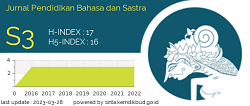Analisis Kesalahan Penggunaan Modalitas Epistemik dan Deontik ~Hazu Dan Beki pada Pembelajar Tingkat Menengah
Abstract
This study aims to obtain an overview of the errors in the use of ~hazu and ~beki modalities that occur in intermediate Japanese learners. This research is motivated by the similarity of the meanings of these two modalities if they are changed into Indonesian. This is what makes it difficult for students to use these two modalities. The method used in this study is a qualitative descriptive method supported by quantitative data. The instruments used were tests and questionnaires. Then, through the results of data analysis, it is known that the ~beki modality is the modality that has more errors than the ~hazu modality. It is also known that the meaning of the ~beki modality which expresses regret is the meaning of the ~beki modality which is the most prone to errors. As for the ~hazu modality, the meaning of the ~hazu modality which states a logical conclusion is the meaning of the ~hazu modality which is the most prone to errors. Furthermore, the type of alternating form error is the most common type of error that occurs in this study. This makes there is a tendency that the mistakes that occur in this middle-level learner are errors due to the respondent's competency factor.
Keywords
Full Text:
PDFReferences
Aghniya, D F. (2021). Analisis Kontrastif Modalitas Epistemik dan Deontik Nakerebanaranai, Beki dan Hazu Dengan Harus dan Seharusnya. Diakses melalui: http://repository.upi.edu/
Akiba, D. (2006). 「はず」の意味と統語構造. Sophia Linguistica: Working Papers In Linguistics.
Ari, A., & Hari, S. (2020). Penggunaan dan Fungsi Kalimat Kondisional Bahasa Jepang “to”,“tara”,“reba” dan “nara” Berdasarkan Modalitas dan Teori Teritori Informasi. Jurnal Lingua Applicata, 4(1), 41-52.
Fennie, F., & Novianti, N. (2010). Perbedaan Fungsi Penggunaan Modalitas Nakerebanaranai, Beki dan Hazu dalam Komik Chibi Maruko Chan dan Detektif Conan. Lingua Cultura, 4(2), 191-200.
Ichikawa, Y. (1997). Nihongo no Goyou Kenkyuu. Tokyo: Tokyo Daigaku Ryuugakusei Sentaa Kyouju.
Johana, J, et al. (2018). Penerjemahan Modalitas Dalam Teks Bahasa Jepang Ke Dalam Teks Bahasa Indonesia. Jurnal Taiyou, 1(1), 10-12.
Kim, H. (2015). Kaiwa Ni Okeru `bekida' No Imi Kinō Ni Kansuru Ichikōsatsu. Rìběn Xué Yánjiū vol.46. Diakses melalui: www.kci.go.kr
Miyazaki K, et al. (2002). Shin Nihongo Bunpou Sensho: Modariti: Tokyo: Kuroshio
Mo, S.J., & Song S. (2014). ‘Wake da’ To ‘Hazu da’ no Imi Kankei ni Tsuite. Journal of Japanese Language and Culture. Diakses melalui: www.kci.go.kr
Sakoda, K. (2002). Nihongo Kyouiku ni Ikasu: Dai Ni Gengo Shuutoku. Tokyo: Aruku
Sutedi, D. (2019). Dasar-dasar Linguistik Bahasa Jepang. Bandung: Humaniora.
Taulia, T. (2016). Modalitas Bahasa Jepang Pada Wacana Watashi No Nichiyoubi. Jurnal Bahas Unimed, 27(2), 76860.
Winingsih, I. (2019). Modalitas Bahasa Jepang dalam Kalimat Berpola~ To Omou. Japanese Research on Linguistics, Literature, and Culture, 2(1), 1-15.
Yasuko I. (1997). Nihongo Reibunshou Jiten. Tokyo: Bonjinsha
DOI: https://doi.org/10.17509/bs_jpbsp.v22i2.55917
Refbacks
- There are currently no refbacks.
Copyright (c) 2023 Jurnal Pendidikan Bahasa dan Sastra
p-ISSN 1412-0712 | e-ISSN 2527-8312
JPBS is published by:
Fakultas Pendidikan Bahasa dan Sastra (Faculty of Language and Literature Education), Universitas Pendidikan Indonesia,
in cooperation with
TEFLIN, and APPBIPA


